One of the most severe complications of diabetes affecting the eyes is the ocular lesion, which is also known as diabetic retinopathy (DR). The key to halting the worsening of diabetic retinopathy is early diagnosis, strict glycemic control, and proper care. Besides, providing people with eye-health education on diabetes retinopathy and instruction for choosing low-vision aids is also crucial for preventing vision loss and keeping quality of life for as long as possible. This article delves into the subject of vision loss symptoms caused by diabetic retinopathy, reviews the pathogenesis, and diagnosis as well as the importance of low vision technology in diabetic retinopathy management.
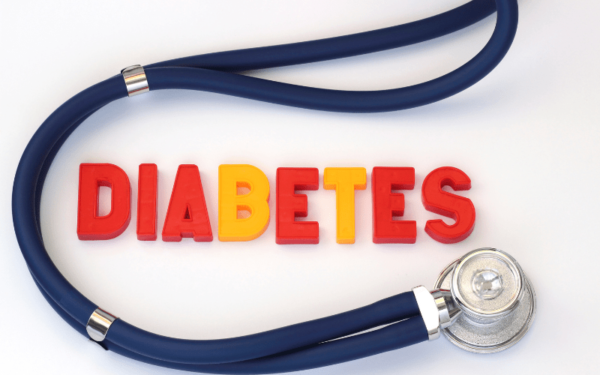
Statistics on Diabetes Mellitus and Diabetic Retinopathy Worldwide
Diabetes mellitus is caused by hyposecretion or hypoactivity of insulin, resulting in high blood glucose levels. Diabetes mellitus is expected to expand rapidly from an estimated 382 million people in 2013 to 592 million by 2030 (Stitt et al., 2016). As the most common microvascular complication of diabetes mellitus, diabetic retinopathy is one of the primary causes of visual impairment and blindness all over the world, particularly in those who are of working age. The occurrence of diabetic retinopathy is primarily related to the duration and control of diabetes, and it occurs among those who have a long history of poorly controlled diabetes. According to statistics, more than 60% of diabetics will develop diabetic retinopathy after 20 years, with maculopathy being the most common cause of central vision loss. Additionally, diabetic retinopathy can cause irreversible damage to the retina, which may result in permanent vision loss or visual disturbances.
Read More: About Diabetic Retinopathy
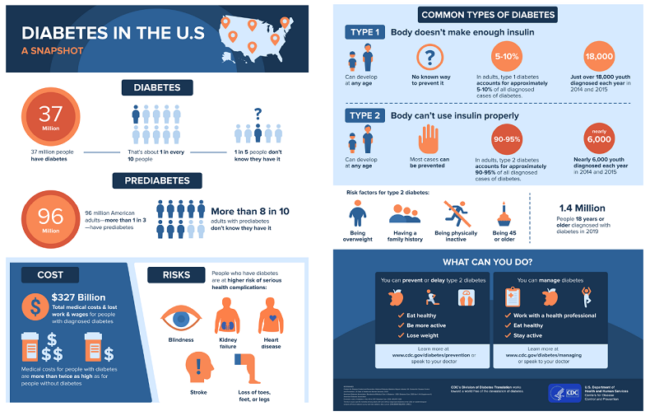
Vision Loss Symptoms with Diabetic Retinopathy (DR)
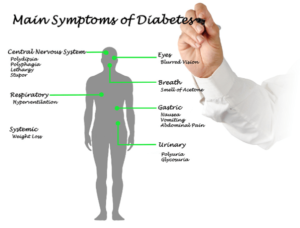 Diabetic maculopathy manifests itself clinically as a focal or diffuse thickening or edema of the retina-- which is due to the breakdown of the inner blood-retinal barrier at the level of the retinal capillary endothelium. Because of this, fluid and plasma constituents are at a higher risk of leakage into the surrounding retina.
Diabetic maculopathy manifests itself clinically as a focal or diffuse thickening or edema of the retina-- which is due to the breakdown of the inner blood-retinal barrier at the level of the retinal capillary endothelium. Because of this, fluid and plasma constituents are at a higher risk of leakage into the surrounding retina.
Vision Loss Symptoms at Early Stage of Diabetic Retinopathy
At the early stage of diabetic retinopathy (also known as nonproliferative diabetic retinopathy), the walls of the blood vessels(in the retina) get weakened and swell, and form pouches as well. These pouches may leak blood and other fluids that cause a portion of the retina swelling (known as macular edema), which in turn severely harms your vision. Macular edema is the usual symptom associated with the mild form of diabetic retinopathy, which affects approximately half of all diabetes patients. However, as shown by certain diabetic groups, it is still possible to have 20/20 vision even if someone has been diagnosed with diabetic retinopathy. Therefore, eye condition monitoring should not be neglected, even at the early stage of diabetic retinopathy. Early signs of diabetic retinopathy include: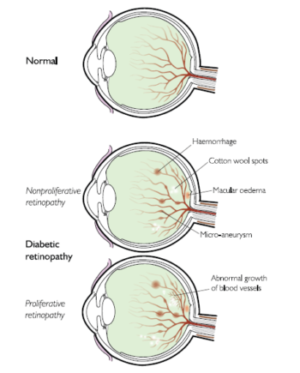
- Cloudy vision
- Double vision
- Eye redness or soreness
- Seeing spots or floaters
- Loss of peripheral vision
- Have trouble seeing at night
- Having blurry vision in one eye or both eye
Vision Loss Symptoms at Advanced Stage of Diabetic Retinopathy
The advanced stage of diabetic retinopathy, namely proliferative diabetic retinopathy (PDR), is a more severe aggravation than nonproliferative diabetic retinopathy (NPDR). At the advanced stage of diabetic retinopathy, new blood vessels start to form in the retina, and both central and peripheral vision loss would occur. With the formation of new blood vessels, the vitreous (the clear gel between the lens and retina) will progressively be filled with these blood vessels: when the amount of bleeding is minimal, a few black dots may float in the field of vision; when there are high levels of bleeding, the vision may become entirely blocked.
The following symptoms can be seen in the advanced stage:
- Vision loss
- Blurry vision
- Having difficulty distinguishing colors
- Void or dark spots in the field of vision
- Spots or dark things floating in your vision
Read More: About Diabetic Retinopathy_-- Nonproliferative diabetic retinopathy (NPDR) and Proliferative diabetic retinopathy (PDR)
How to Manage People with Diabetic Retinopathy?
As discussed above, the retina undergoes visible alterations before the visual loss; hence, early detection and treatment of diabetic retinopathy should be conducted. Treatment is of necessity if diabetic retinopathy has reached a significant stage, that is, any retinal thickening within 500 microns of the fovea, hard exudates within 500 microns of the fovea associated with retinal thickening, or retinal thickening greater than one disc diameter in size, of which any part lies within one disc diameter of the fovea (Watkinson, 2014).

1. Treatment Options for Diabetic Retinopathy
A care program that combines measures of early detection with the appropriate treatment of diabetic retinopathy can significantly reduce the risk of visual impairment and blindness among diabetic patients. Vitrectomy and laser photocoagulation are two major treatment options for diabetic retinopathy. To be specific,
- A vitrectomy is performed for chronic vitreous hemorrhage and tractional retinal detachment including the macula.
- Laser photocoagulation is performed mainly for focal and diffuse maculopathy, as well as proliferative retinopathy.
It is crucial to recognize that screening for and treatment of diabetic retinopathy will not prevent all occurrences of visual impairment but can play a significant role in substantially reducing the risk of permanent and irreparable vision loss as the direct result of diabetic retinopathy.

2. Low-Vision Aids for People with Diabetic Retinopathy
Ophthalmologists may also recommend low-vision aids for diabetic patients. Various low-vision technologies can assist you in accessing the Internet, reading books or medicine labels, determining distances, and more. Working with an occupational therapist or low-vision specialist who can assist with how to use low-vision devices can reduce the effects of visual degradation and enhance the quality of life for diabetic retinopathy patients.
Low Vision Electronic Video Magnifier
If you have diabetic macular edema, you may have the fluctuating vision, namely, frequent changes in visual acuity. Besides immediate medical treatment, electronic video magnifiers can assist you in reading or viewing, and provide you with varying levels of magnification, different-sized fonts, as well as contrast.
Electronic video magnifiers are available in various sizes and configurations. Desktop electronic video magnifiers function similarly to a camera by displaying an enlarged image on a monitor or computer-size screen. Like Zoomax Luna HD 24 Pro, which is one of the most popular hands-free visual assistance. It is designed for use both at home and in the workplace and enables diabetic patients to easily adjust the size of the font and the color contrast of the setting.
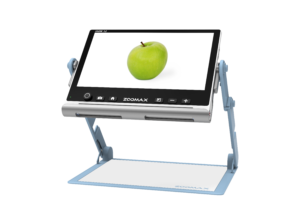
Handheld low-vision video magnifiers are pock-sized and easy to use, and portable electronic video magnifiers can prop themselves up on a page or other object. Both types of low-vision devices can make it easier for diabetic patients to see objects up close, far away, and everywhere in between. Zoomax Snow 12, Luna 6, Luna S, etc. are all members of this distinguished group of electronic magnifying aids.
Head-Mounted Low-Vision E-glasses
Most people are very complimentary of the application of VR and AR technology in the low-vision field. In comparison to electronic video magnifiers, wearable low-vision solutions, such as low-vision E-glasses, not only overcome visual barriers but also allow diabetic patients to live independently. As hands-free solutions, low vision E-glasses can better ensure users get ready for daily activities, whether they are reading, hiking, or dealing with daily chores. The Acesight series are suitable for diabetic retinopathy: Acesight family of head-mounted displays apply AR and VR technology to help people recognize faces, watch movies, identify the environment, and more. Patients with diabetes can select Zoomax Acesight VR or Acesight/Acesight S according to their eye condition with the guidance of eye doctors or professionals.

Read more: Low Vision E-glasses: Hands-free Solution for Visual Impairments
Attention: please contact the public organization or institution for the visually impaired in your region if you or your friends are looking for financial assistance for purchasing low-vision aids.
3. Health Education and Making Lifestyle Changes
Medical professionals emphasize the benefits of maintaining a healthy and well-balanced diet: the sources of carbohydrates should be high in fiber and low on the glycemic index, in the short term, fruits, vegetables, whole grains, and pulses, should be encouraged. Oily fish and low-fat dairy products are healthy, and consuming foods high in saturated and trans fatty acids should be limited. Furthermore, dietary advice should be combined with other parts of lifestyle adjustment, such as advice on increasing physical activity and weight-reducing.
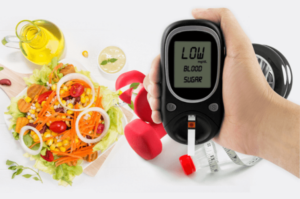 People with diabetic retinopathy, on the other hand, will experience the economic and psychological burdens that caused by visual impairment. To enable diabetic patients to take charge of their health and diabetes management, healthcare institutions should provide multiple opportunities for health promotion and promote long-term ocular wellness. Meanwhile, individuals should also take responsibility for making healthy lifestyle adjustments and building self-belief that they are capable of managing diabetes.
People with diabetic retinopathy, on the other hand, will experience the economic and psychological burdens that caused by visual impairment. To enable diabetic patients to take charge of their health and diabetes management, healthcare institutions should provide multiple opportunities for health promotion and promote long-term ocular wellness. Meanwhile, individuals should also take responsibility for making healthy lifestyle adjustments and building self-belief that they are capable of managing diabetes.
For More: Diabetes Self-Management Education and Support (DSMES)

References:
https://www.sciencedirect.com/science/article/abs/pii/S135094621500066X#preview-section-snippets
Watkinson, S. (2014). Older People with Visual Impairment – Clinical Management and Care (1st ed.). M&K Publishing.

